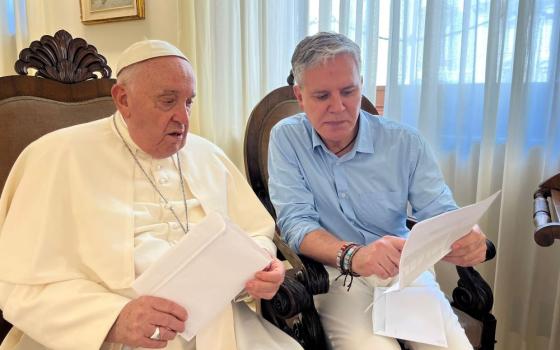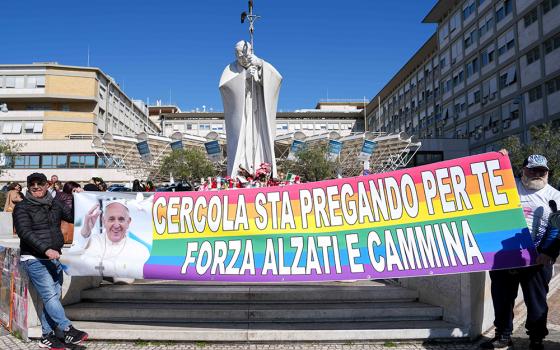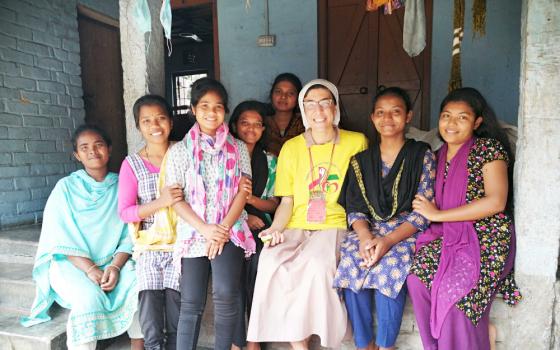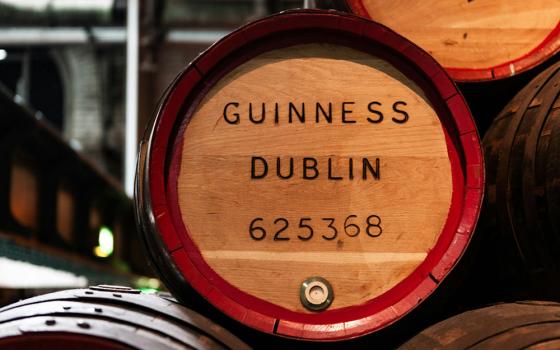Standing in the window of the library of the Apostolic Palace overlooking an empty St. Peter's Square, March 29, Pope Francis blesses the city of Rome, which was under lockdown to prevent the spread of the coronavirus. (CNS/Vatican Media)
The biggest news story of 2020 is undoubtedly the coronavirus pandemic. One small virus has changed the way we live, learn and connect with other people, most likely for the foreseeable future. And although the coronavirus has impacted the Catholic Church in a multitude of ways, non-virus-related news also had a major impact.
The top 10 most read news stories on NCR's website for 2020 are dedicated to the topics of the coronavirus pandemic, the ever-present clerical sexual abuse scandal in the Catholic Church, the entwining of the U.S. bishops with the Republican Party, and the evolving discussion of married priests, to name a few.
These are NCR's most read — not necessarily the most important — news stories and are listed in order by the number of site visitors who read the story. You can see what NCR's most read opinion and commentary pieces were for 2020 here.
1. In surprise, Benedict openly defends clerical celibacy as Francis considers married priests
In January, news broke that retired Pope Benedict XVI coauthored a book defending the Catholic Church's practice of a celibate priesthood, just a few months after Pope Francis was speculated to be considering the possibility of allowing older, married men to be ordained as priests in the Amazon region.
The book, titled From the Depths of Our Hearts, was co-written with Cardinal Robert Sarah, the head of the Vatican's liturgy office.
The day after a dramatic public dispute between Sarah and Archbishop Georg Gänswein, Benedict's private secretary, Benedict's name was removed as coauthor despite Sarah's repeated insistence defending the choice to list the former pope's name. Gänswein, however, said that Benedict only thought he was preparing an essay for the volume, and did not intend to be listed as a coauthor.
A month later, Francis released his apostolic exhortation, Querida Amazonia, in which he did not grant the request from the Catholic bishops of the Amazon to allow for the priestly ordination of married men in their territories in order to address a severe lack of ministers across the nine-nation region.
The document instead focuses primarily on calling the church across the region to continue its struggle against the unrestrained development taking place in one of the world's most biodiverse areas.
Advertisement
2. The night that broke Jim Gaffigan, the 'clean' Catholic comedian
On the last night of the Republican National Convention in late August, Jim Gaffigan lost it. The every-dad Catholic comedian pivoted to politics, in a flurry of invective-filled tweets responding to President Donald Trump's speech on why he deserved four more years in the White House.
The comedian, who has an avid following among Catholics, repeatedly called the president "a liar," "a crook," "a con man" and "RADICAL," and called out Trump supporters, even those among his own fans, to wake up.
He defended his rant on Facebook a few days later.
3. Texas bishop endorses video claiming faithful Catholics can't support Democratic candidates
In early September, Bishop Joseph Strickland of Tyler, Texas, endorsed a video that included anti-immigrant remarks and homophobic slurs by a priest of Wisconsin in which the priest claims, "You cannot be Catholic and be a Democrat."
The video was released by Fr. James Altman, pastor of St. James the Less Catholic Church in La Crosse, Wisconsin. In the 10-minute video, set to ominous music and dark lighting, the priest slams Archbishop Wilton Gregory of Washington, D.C., for his criticism of Trump's June photo-op and appearance at the St. John Paul II National Shrine.
In October, Altman continued his campaign for President Donald Trump, at an indoor speech in Chicago, where he appeared to violate quarantine orders.
4. Is St. Corona the patron saint of pandemics?
In March, at the beginning of the spread of the coronavirus pandemic in the United States, much was unknown, including just exactly who the patron saint of pandemics is.
It's not St. Corona, although her story spread quickly on social media. St. Corona is the patron saint of treasure hunters, which has little to do with her story and more to do with a treasure hunter who credited his success to her intercession.
But this story does not begin to encompass all of NCR's coverage of the pandemic.
The coronavirus pandemic caused many businesses, schools, parishes and more to shut down for months in an attempt to get the infection rate under control. These stories look at the restrictions that have been put in place to keep the spread of coronavirus in check.
The pandemic also fundamentally changed how we do and be church. This collection of stories looked at what these changes could mean for the Catholic Church long-term.
On Holy Thursday, Pope Francis prayed for the dead as well as for the priests, doctors and nurses he said represented the "saints next door" during the coronavirus pandemic. Here, you can read the stories of Catholics in this crisis: those who have died and those whose service brings hope.
5. Coronavirus indulgences evoke Francis' 'ridiculously-pardoning' church
In a March decree, the Vatican offered new plenary indulgences to those around the world affected by the coronavirus.
Theologians said the move, made from the apostolic penitentiary, shows a seemingly unprecedented level of pastoral care for those who suffer from the virus — especially those who may die in isolation without being able to receive final rites.
In October, Pope Francis released his encyclical letter, Fratelli Tutti, which laid out a comprehensive vision for how the world should change after the coronavirus pandemic, imagining more caring societies that focus on helping those in need and are less attached to the principles of market capitalism.
Then in early December, Francis decreed a special year dedicated to St. Joseph, comparing Joseph, Jesus' foster father, to the many unheralded essential workers keeping society afloat in times of social distancing and remote work.
Protesters in Salem, Oregon, break the door to the state capitol building during a Dec. 21 protest against restrictions to prevent the spread of coronavirus disease. (CNS/Reuters/Mathieu Lewis-Rolland)
6. COVID-19 is not God's judgment, but a call to live differently, pope says
One of the most striking Catholic images of 2020 is Francis in a rain-drenched, dark and empty St. Peter's Square, giving a meditation on the meaning of the COVID-19 pandemic and its implications for humanity before raising a monstrance with the Blessed Sacrament and giving an extraordinary blessing urbi et orbi (to the city and the world).
The pandemic, the pope said, has exposed "our vulnerability and uncovers those false and superfluous certainties around which we have constructed our daily schedules, our projects, our habits and priorities."
7. Polish church reels from new claims against John Paul II
The long-awaited report on the case of disgraced ex-Cardinal Theodore McCarrick was published by the Vatican in early November.
The extensive document highlighted mistakes by the last three popes, but particularly questioned judgments by St. John Paul II, a figure long considered beyond criticism in his homeland of Poland.
It was made clear in the report that the late Pope John Paul II decided to appoint the priest as archbishop of Washington despite repeated warnings from high-level advisers.
The role of the Polish pontiff's long-serving secretary, retired Cardinal Stanislaw Dziwisz, has also been examined by a Polish TV documentary, citing damning evidence that he connived in covering up sex abuse by Catholic clergy both in Rome and in Poland.
8. Priests, parishes share Viganò's letter to Trump
Archbishop Carlo Maria Viganò sent a letter to President Donald Trump in June, claiming that he and the U.S. president were united in a cosmic battle between the forces of good and evil.
Across the country, priests have used their homilies, bulletins and parish social media to promote Viganò, who since issuing an 11-page testimonial manifesto against Francis in August 2018 has been heralded by many right-wing Catholics as leading the resistance to Francis' papacy.
Trump tweeted out Viganò's letter (originally published on the right-wing website LifeSiteNews) to his 82 million followers, along with his praise of the archbishop, helping to dramatically increase its reach and Viganò's public profile.
Then-Cardinal Theodore McCarrick embraces Pope John Paul II after receiving his biretta, the four-cornered red cardinal's hat, during a consistory ceremony in St. Peter's Square in Vatican City Feb. 21, 2001. (CNS/Reuters/Vincenzo Pinto)
9. Exclusive: Dolan sends book on 'The Next Pope' to cardinals around the world
In July, New York Cardinal Timothy Dolan forwarded copies of a book that suggests qualities desirable in a future pope to cardinals across the globe.
Four cardinals in various parts of the world confirmed to NCR receipt of the volume, sent by Ignatius Press with an accompanying note from Dolan. The book is George Weigel's The Next Pope: The Office of Peter and a Church in Mission.
The four prelates, who spoke on condition of anonymity, each expressed concern about the propriety of a member of the elite College of Cardinals sending such a book while the current pontiff is not known to be ill or considering resignation.
10. Churches and schools not expected to quickly change John Paul II name
Pope John Paul II's canonization has been increasingly questioned in light of the Vatican report detailing abuses committed by McCarrick, but don't look for quick name changes on the scores of Catholic schools and other institutions named after him.
In the United States, there are more than 40 schools named after John Paul II — at least 20 primary schools, 20 secondary schools and one university. In addition, churches, foundations, organizations, public spaces and shrines called "St. John Paul II," "Pope John Paul II" and "John Paul the Great" can be found all over the country and the world.
The names of parishes and diocesan schools are decided by dioceses, school and church administrators say, and bishops did not call for or discuss the renaming of any institutions during their fall assembly.







